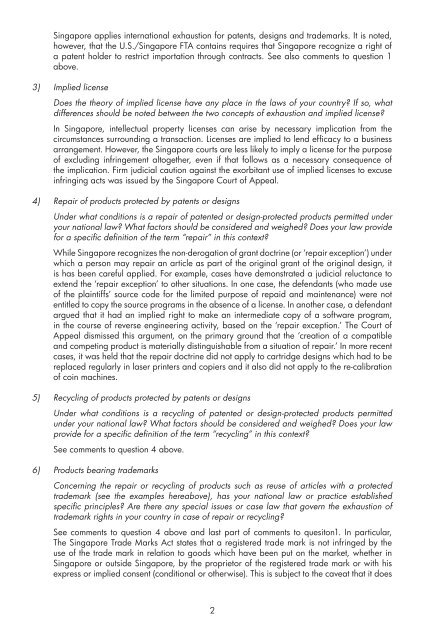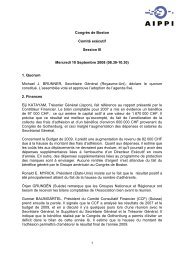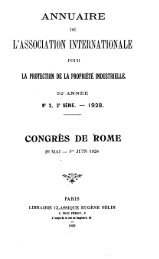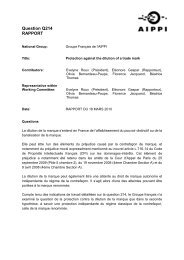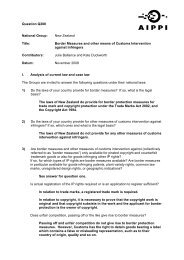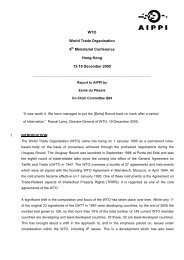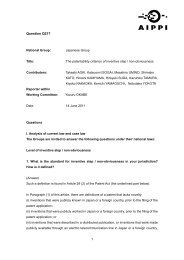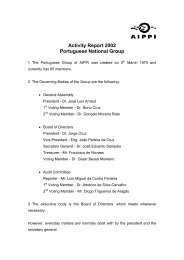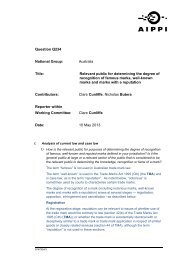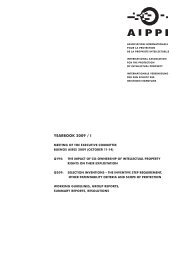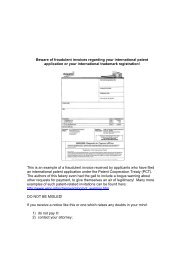1 Singapore Singapour Singapur Report Q205 in the name ... - AIPPI
1 Singapore Singapour Singapur Report Q205 in the name ... - AIPPI
1 Singapore Singapour Singapur Report Q205 in the name ... - AIPPI
You also want an ePaper? Increase the reach of your titles
YUMPU automatically turns print PDFs into web optimized ePapers that Google loves.
<strong>S<strong>in</strong>gapore</strong> applies <strong>in</strong>ternational exhaustion for patents, designs and trademarks. It is noted,<br />
however, that <strong>the</strong> U.S./<strong>S<strong>in</strong>gapore</strong> FTA conta<strong>in</strong>s requires that <strong>S<strong>in</strong>gapore</strong> recognize a right of<br />
a patent holder to restrict importation through contracts. See also comments to question 1<br />
above.<br />
3) Implied license<br />
Does <strong>the</strong> <strong>the</strong>ory of implied license have any place <strong>in</strong> <strong>the</strong> laws of your country? If so, what<br />
differences should be noted between <strong>the</strong> two concepts of exhaustion and implied license?<br />
In <strong>S<strong>in</strong>gapore</strong>, <strong>in</strong>tellectual property licenses can arise by necessary implication from <strong>the</strong><br />
circumstances surround<strong>in</strong>g a transaction. Licenses are implied to lend efficacy to a bus<strong>in</strong>ess<br />
arrangement. However, <strong>the</strong> <strong>S<strong>in</strong>gapore</strong> courts are less likely to imply a license for <strong>the</strong> purpose<br />
of exclud<strong>in</strong>g <strong>in</strong>fr<strong>in</strong>gement altoge<strong>the</strong>r, even if that follows as a necessary consequence of<br />
<strong>the</strong> implication. Firm judicial caution aga<strong>in</strong>st <strong>the</strong> exorbitant use of implied licenses to excuse<br />
<strong>in</strong>fr<strong>in</strong>g<strong>in</strong>g acts was issued by <strong>the</strong> <strong>S<strong>in</strong>gapore</strong> Court of Appeal.<br />
4) Repair of products protected by patents or designs<br />
Under what conditions is a repair of patented or design-protected products permitted under<br />
your national law? What factors should be considered and weighed? Does your law provide<br />
for a specific def<strong>in</strong>ition of <strong>the</strong> term “repair” <strong>in</strong> this context?<br />
While <strong>S<strong>in</strong>gapore</strong> recognizes <strong>the</strong> non-derogation of grant doctr<strong>in</strong>e (or ‘repair exception’) under<br />
which a person may repair an article as part of <strong>the</strong> orig<strong>in</strong>al grant of <strong>the</strong> orig<strong>in</strong>al design, it<br />
is has been careful applied. For example, cases have demonstrated a judicial reluctance to<br />
extend <strong>the</strong> ‘repair exception’ to o<strong>the</strong>r situations. In one case, <strong>the</strong> defendants (who made use<br />
of <strong>the</strong> pla<strong>in</strong>tiffs’ source code for <strong>the</strong> limited purpose of repaid and ma<strong>in</strong>tenance) were not<br />
entitled to copy <strong>the</strong> source programs <strong>in</strong> <strong>the</strong> absence of a license. In ano<strong>the</strong>r case, a defendant<br />
argued that it had an implied right to make an <strong>in</strong>termediate copy of a software program,<br />
<strong>in</strong> <strong>the</strong> course of reverse eng<strong>in</strong>eer<strong>in</strong>g activity, based on <strong>the</strong> ‘repair exception.’ The Court of<br />
Appeal dismissed this argument, on <strong>the</strong> primary ground that <strong>the</strong> ‘creation of a compatible<br />
and compet<strong>in</strong>g product is materially dist<strong>in</strong>guishable from a situation of repair.’ In more recent<br />
cases, it was held that <strong>the</strong> repair doctr<strong>in</strong>e did not apply to cartridge designs which had to be<br />
replaced regularly <strong>in</strong> laser pr<strong>in</strong>ters and copiers and it also did not apply to <strong>the</strong> re-calibration<br />
of co<strong>in</strong> mach<strong>in</strong>es.<br />
5) Recycl<strong>in</strong>g of products protected by patents or designs<br />
Under what conditions is a recycl<strong>in</strong>g of patented or design-protected products permitted<br />
under your national law? What factors should be considered and weighed? Does your law<br />
provide for a specific def<strong>in</strong>ition of <strong>the</strong> term “recycl<strong>in</strong>g” <strong>in</strong> this context?<br />
See comments to question 4 above.<br />
6) Products bear<strong>in</strong>g trademarks<br />
Concern<strong>in</strong>g <strong>the</strong> repair or recycl<strong>in</strong>g of products such as reuse of articles with a protected<br />
trademark (see <strong>the</strong> examples hereabove), has your national law or practice established<br />
specific pr<strong>in</strong>ciples? Are <strong>the</strong>re any special issues or case law that govern <strong>the</strong> exhaustion of<br />
trademark rights <strong>in</strong> your country <strong>in</strong> case of repair or recycl<strong>in</strong>g?<br />
See comments to question 4 above and last part of comments to quesiton1. In particular,<br />
The <strong>S<strong>in</strong>gapore</strong> Trade Marks Act states that a registered trade mark is not <strong>in</strong>fr<strong>in</strong>ged by <strong>the</strong><br />
use of <strong>the</strong> trade mark <strong>in</strong> relation to goods which have been put on <strong>the</strong> market, whe<strong>the</strong>r <strong>in</strong><br />
<strong>S<strong>in</strong>gapore</strong> or outside <strong>S<strong>in</strong>gapore</strong>, by <strong>the</strong> proprietor of <strong>the</strong> registered trade mark or with his<br />
express or implied consent (conditional or o<strong>the</strong>rwise). This is subject to <strong>the</strong> caveat that it does<br />
2


